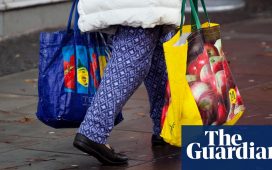The logo of McDonald’s (MCD) is seen in Los Angeles, California.
Lucy Nicholson | Reuters
McDonald’s on Thursday reported mixed quarterly results as its U.S. same-store sales fell for the second straight quarter, posting their largest domestic decline since the onset of the Covid pandemic.
McDonald’s U.S. same-store sales shrank 3.6% as the chain faced bad weather and a more cautious consumer. That drop is the worst in McDonald’s home market since the 8.7% plunge during the second quarter of 2020, when states imposed lockdowns to slow the spread of Covid.
Analysts surveyed by StreetAccount were expecting the company to report domestic same-store sales declines of 1.7% for the first quarter.
“In the U.S., overall [quick-service restaurant] industry traffic from the low-income consumer cohort was down nearly double digits versus the prior year quarter,” CEO Chris Kempczinski said on the company’s conference call. “Unlike a few months ago, QSR traffic from middle-income consumers fell nearly as much, a clear indication that the economic pressure on traffic has broadened.”
Across all of its markets, McDonald’s same-store sales fell 1% during the quarter, hurt by comparisons to last year’s Leap Day, the company said.
Shares of the company roughly 2% in premarket trading.
Here’s what the company reported for the first quarter compared with what Wall Street was expecting, based on a survey of analysts by LSEG:
- Earnings per share: $2.67 adjusted vs. $2.66 expected
- Revenue: $5.96 billion vs. $6.09 billion expected
The fast-food giant reported first-quarter net income of $1.87 billion, or $2.60 per share, down from $1.93 billion, or $2.66 per share, a year earlier.
Excluding restructuring charges and other items, McDonald’s earned $2.67 per share.
Net sales dropped 3% to $5.96 billion.
Back in February, CFO Ian Borden said he expected the first quarter to be the low point for McDonald’s same-store sales, in part due to a weak start to the year in the U.S. Since then, President Donald Trump has introduced broad tariffs, heightening pricing concerns for some consumers.
For its part, McDonald’s has already said that it plans to lean into value meals and buzzy menu items, like the return of its snack wraps, to bring diners back to its restaurants this year.
Outside the U.S., McDonald’s saw same-store sales fall 1% in its international operated markets, which include Australia and France. The segment includes McDonald’s largest international markets and accounts for roughly half of its revenue. Analysts had projected flat same-store sales in the segment for the quarter.
“In most of our major markets, we’re seeing a similar story in regards to the challenging industry environment and softening consumer sentiment,” Borden said on the company’s earnings call.
The company’s international developmental licensed markets division reported same-store sales growth of 3.5%, narrowly beating analyst estimates of 3.2%. That segment includes Japan, China and Brazil.
McDonald’s on Thursday reiterated its full-year outlook, including plans to open 2,200 locations and to spend between $3 billion and $3.2 billion on capital expenditures, the company said in a regulatory filing. The company is projecting that net restaurant openings will boost its system-wide sales growth by slightly more than 2%.
This story is developing. Please check back for updates.
— CNBC’s Robert Hum contributed to this report.








